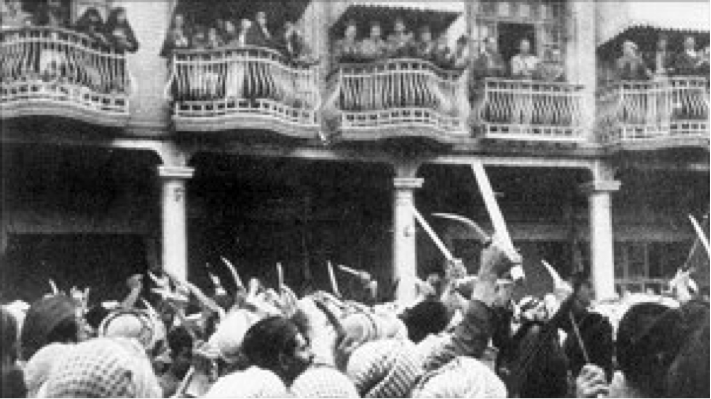Sixties Fan
Diamond Member
- Mar 6, 2017
- 67,285
- 12,048
- 2,290
[ Which Arab Clan became the leader of the Arabs in Mandate for Palestine, post the Ottoman Empire defeat, shows what a difference power and leadership makes.
One clan wanted to live with the Jews in the recreation of their ancient Nation, the other wanted all Jews gone. The latter one fought, killed or expelled the leaders of the clans who were against his plans. The consequences to the Mandate for Palestine, the Jews and the Arabs themselves have been catastrophic for both sides.
His reach and influence in delaying the Jewish dream until 1948 can be seen from the riots he created in 1920 to later efforts even outside the Mandate for Palestine ]
Jews had thrived in Iraq for 2,700 years, a thousand years before Muhammad. But all that came to end when the mufti of Jerusalem, Haj Amin al-Husseini, led the broad Arab-Nazi alliance in the Holocaust that produced a military, economic, political, and ideological common cause with Hitler. Although Husseini spearheaded an international pro-Nazi, anti-Jewish Islamic movement from India to Central Europe to the Middle East, it was in Baghdad — a 1,000-kilometer drive from Jerusalem — that he launched his robust coordination with the Third Reich.
In 1941, Iraq still hosted Britain’s Anglo-Persian Oil Company, which controlled the region’s oil. Hitler wanted that oil to propel his invasion of Russia. The Arabs, led by Husseini, wanted the Jews out of Palestine and Europe’s persecuted Jews kept away from the Middle East. Indeed, Husseini persuasively argued to Hitler that Jews should not be expelled to Palestine but rather to “Poland,” where “they will be under active control.” Translation: send Jews to the concentration camps. Husseini had visited concentration camps. He had been hosted by architect of the genocide Heinrich Himmler, and the mufti considered Shoah engineer Adolf Eichmann not only a great friend, but a “diamond” among men.
Nazi lust for oil and Arab hatred of Jews combined synergistically June 1–2, 1941, burning the Farhud into history. Arab soldiers, police, and hooligans, swearing allegiance to the mufti and Hitler, bolstered by fascist coup plotters known as the Golden Square, ran wild in the streets, raping, shooting, burning, dismembering, and decapitating. Jewish blood flowed through those streets and their screams created echoes that have never faded.
The 1941 Farhud massacre, which was launched in tandem with an attempted takeover of the British oil fields and London’s airbase at Habbaniya, set the stage for the Mufti-Hitler summit and the establishment of three Islamic and Arab Waffen SS divisions in central Europe under Himmler’s direct sponsorship. After the State of Israel was established in 1948, mufti adherents and devotees throughout the Arab world, working through the Arab League, openly and systematically expelled 850,000 Jews from Morocco to Lebanon. Penniless and stateless, many of those refugees were airlifted to Israel where they were absorbed and became almost half the families of Israel.
(full article online)
Why International Farhud Day Stymies Invented Palestinian History

The Farhud, Baghdad, 1941. Photo: Jewish Museum London
One clan wanted to live with the Jews in the recreation of their ancient Nation, the other wanted all Jews gone. The latter one fought, killed or expelled the leaders of the clans who were against his plans. The consequences to the Mandate for Palestine, the Jews and the Arabs themselves have been catastrophic for both sides.
His reach and influence in delaying the Jewish dream until 1948 can be seen from the riots he created in 1920 to later efforts even outside the Mandate for Palestine ]
Jews had thrived in Iraq for 2,700 years, a thousand years before Muhammad. But all that came to end when the mufti of Jerusalem, Haj Amin al-Husseini, led the broad Arab-Nazi alliance in the Holocaust that produced a military, economic, political, and ideological common cause with Hitler. Although Husseini spearheaded an international pro-Nazi, anti-Jewish Islamic movement from India to Central Europe to the Middle East, it was in Baghdad — a 1,000-kilometer drive from Jerusalem — that he launched his robust coordination with the Third Reich.
In 1941, Iraq still hosted Britain’s Anglo-Persian Oil Company, which controlled the region’s oil. Hitler wanted that oil to propel his invasion of Russia. The Arabs, led by Husseini, wanted the Jews out of Palestine and Europe’s persecuted Jews kept away from the Middle East. Indeed, Husseini persuasively argued to Hitler that Jews should not be expelled to Palestine but rather to “Poland,” where “they will be under active control.” Translation: send Jews to the concentration camps. Husseini had visited concentration camps. He had been hosted by architect of the genocide Heinrich Himmler, and the mufti considered Shoah engineer Adolf Eichmann not only a great friend, but a “diamond” among men.
Nazi lust for oil and Arab hatred of Jews combined synergistically June 1–2, 1941, burning the Farhud into history. Arab soldiers, police, and hooligans, swearing allegiance to the mufti and Hitler, bolstered by fascist coup plotters known as the Golden Square, ran wild in the streets, raping, shooting, burning, dismembering, and decapitating. Jewish blood flowed through those streets and their screams created echoes that have never faded.
The 1941 Farhud massacre, which was launched in tandem with an attempted takeover of the British oil fields and London’s airbase at Habbaniya, set the stage for the Mufti-Hitler summit and the establishment of three Islamic and Arab Waffen SS divisions in central Europe under Himmler’s direct sponsorship. After the State of Israel was established in 1948, mufti adherents and devotees throughout the Arab world, working through the Arab League, openly and systematically expelled 850,000 Jews from Morocco to Lebanon. Penniless and stateless, many of those refugees were airlifted to Israel where they were absorbed and became almost half the families of Israel.
(full article online)
Why International Farhud Day Stymies Invented Palestinian History

The Farhud, Baghdad, 1941. Photo: Jewish Museum London

